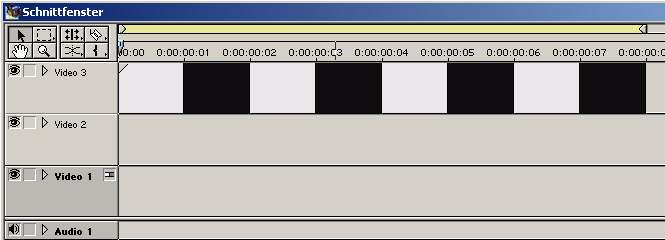
|
||||||||
|
||||||||
|
Das hier beschriebene Verfahren bezieht sich auf etwas älteres Equipment wie z.B. eine DV-Kamera, welche noch mit Halbbildern aufgenommen hat. Zu dieser Zeit gab es ein Problem eine flüssige Zeitlupe darzustellen. Das lag daran, daß viele der günstigeren Schnittprogramme zur Erstellung einer Zeitlupe nur eines der beiden Halbbilder einer DV-Kamera-Aufnahme verwendet haben und das vollständige Bild mit Hilfe der Interpolation eines der beiden Halbbilder erzeugt haben, d.h. die Filmsequenz, die man in eine Zeitlupe umwandeln will, wird zuerst Deinterlaced und dann einfach verlangsamt. Das führt dazu, daß Bewegungen ruckelig und abgehackt aussehen. Sinnvoller wäre es wenn man schon Deinterlaced beide Halbbilder zu verwenden. Wir errinnern uns: DV-Material besteht aus 50 Halbbildern pro Sekunde. Rechnet man jedes dieser Halbbilder mittels des Deinterlacings und Interpolation in ein Vollbild, so erhält man 50 Frames pro Sekunde. Verlangsamt man den Film um 50% so erhält man die für PAL notwendigen 25 Frames pro Sekunde. Das Ergebnis ist eine 50% Zeitlupe, die wesentlich flüssiger ist, da sie aus mehr Zwischenbildern besteht. Meine Methode die ich hier vorstellen will ist eigentlich ganz simpel: Man nimmt eine DV-Sequenz, legt sie doppelt auf zwei Spuren und verlangsamt beide Spuren um 50%. Dann legt man auf beide Spuren ein Deinterlacing um in Spur 1 das Erste und in Spur 2 das zweite Halbbild zu gewinnen und wechselt mit Hilfe einer bewegten Maske zwischen der ersten und zweiten Spur hin und her. So entsteht eine flüssige, 50 prozentige Zeitlupe. Als Beispielprogramm dient Adobe Premiere 6.5, obwohl ich gestehen muß, daß das hier vorgestellte Verfahren für Adobe Premiere überflüssig ist, da Premiere von Haus aus zur Zeitlupenberechnung beide Halbbilder hernimmt und damit genau dasselbe Ergebnis erzielt wie mein Verfahren. In Programmen jedoch die nur eines der beiden Halbbilder für die Zeitlupenberechnung hernehmen ist mein Verfahren die einzige Möglichkeit für eine flüssige Zeitlupe. Schauen wir uns jetzt die Vorgehensweise im Detail an. Zuerst erstellen wir einen Clip der abwechselnd ein schwarzes und ein weißes Bild enthält. Dieser dient später als bewegte Maske zum wechseln zwischen den beiden Spuren. Durch den schwarz-weiß Wechsel wird jedes zweite Bild in Spur 2 komplett ausgeblendet und somit das darunter liegende Bild in Spur 1 verwendet. |
||||||||
 |
||||||||
| Anschließend fügt man den zu verlangsamenden Clip zweimal ein. Beachtet die Reihenfolge! Der Maskenclip muß als bewegte Maske über den beiden Filmclips sein. | ||||||||
 |
||||||||
| Dann verlangsamt man die Geschwindigkeit der beiden Clips um 50%. | ||||||||
 |
||||||||
| Schlußendlich wählt man noch für den oberen Clip "Halbbilder immer zusammenfügen" (das ist der Schalter für das Deinterlacing) plus einem Haken in "Halbbilddominanz umkehren" und unter Transparenz die bewegte Maske. Für den unteren Clip wählt man nur "Halbbilder immer zusammenfügen". Das Ergebnis sollte dann so aussehen: | ||||||||
 |
||||||||
|
Einen ersten Eindruck kann man gewinnen durch drücken der ALT-Taste und Scrubben mittels des Cursors im Material. Sollte das Material nicht flüssig laufen, sondern seltsam abgehackt hin und her springen, könnte es sein, daß die falsche Halbbildreihenfolge gewählt wurde. Dies kann man korrigieren indem man im oberen Clip das Häckchen aus "Halbbilddominanz umkehren" rausnimmt und dafür im unteren Clip setzt. Der schwarz-weiß Clip macht jedes zweite Bild des Clips in Spur 2 transparent und läßt das Bild des Clips in Spur 1 durch. Somit wechseln sich die Clips in Spur1 und Spur2 ab und es entsteht das gewünschte Ergebnis mit wesentlich vereinfachterem Arbeitsaufwand, als wie wenn man die einzelnen Frames von Hand abwechselnd hintereinander legen würde. Zum Abschluß noch ein paar Beispielclips. Einmal für das Original, einmal wie eine falsche Halbbildreihenfolge aussieht, einmal eine Zeitlupe mit nur einem Halbbild und einmal die flüssigere, verbesserte Zeitlupe bestehend aus zwei Halbbildern. |
||||||||
|
||||||||
Natürlich funktioniert dieses Verfahren heutzutage nicht mehr, da heutige Camcorder keine Halbbilder mehr aufnehmen, sondern alles in Vollbildern verarbeiten. Nennt man allerdings eine CANON EOS 700D sein eigen und reicht einem die kleinere HD Auflösung mit 1280x720 Pixeln, kann man damit ebenfalls eine flüssige 50 prozentige Zeitlupe erzeugen, da diese Kamera von Haus aus mit 50 fps Vollbilder aufnimmt. Da 25 Frames für eine flüssige Wiedergabe reichen, kann man mit einem Videobearbeitungsprogramm wie VirtualDub einfach die Abspielgeschwindigkeit auf 25 Frames pro Sekunde setzen und schon hat man eine 50 prozentige, flüssige Zeitlupe. |
||||||||
| Zurück zur Auswahl | ||||||||
|
||||||||||||||
|
|
||||||||||||||


